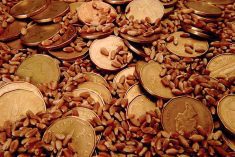* Farmers plant corn rather than sell it
* Front-month soybeans also rise on tight U.S. supplies
* Showers in U.S., Black Sea and Australia weigh on wheat
(Updates with closing prices)
By Sam Nelson and Julie Ingwersen
CHICAGO, May 17 (Reuters) - U.S. corn futures rose 1.8
percent on Friday, reversing three days of declines on strong
cash markets as farmers focused on planting their 2013 crop
rather than selling in the cash market, traders and analysts
said.
Soybeans rose for a second session, with the benchmark July
contract reaching a two-month high on tight U.S. supplies and a
Read Also

June’s fast-moving grain markets
Summing up the grain markets: June 2025 was an interesting month for canola prices and geopolitics stole the spotlight from grain market specifics
firm cash market.
Wheat fell for a third day in a row on technical selling and
crop-friendly rains in key wheat growing areas of the United
States, Australia and the Black Sea.
At the Chicago Board of Trade, July corn settled up
11-1/4 cents at $6.52-3/4 per bushel. July soybeans ended
up 21 cents at $14.48-1/2 per bushel after reaching $14.50, the
contract's highest level since March 12.
Cash markets have been strong, with farmers reluctant to
sell the last of their 2012 corn and soybeans because planting
delays have raised concern about prospects for the 2013 crop.
Weather in the U.S. Midwest improved this week and producers
seized the opportunity to catch up with fieldwork.
"Farmers are busy in the fields and also they know planting
is behind schedule and this could affect acreage or production,
so they're in no hurry to sell since prices could go up," said
Shawn McCambridge, analyst for Jefferies Bache in Chicago.
Cash basis bids for corn in the U.S. Midwest on Friday were
surging at processors and ethanol plants amid strong profit
margins, tight supplies and slow farmer sales, grain merchants
said.
Mostly clear skies allowed U.S. farmers to gain ground in
corn planting after the slowest start in decades.
"They probably got quite a lot done," said Andy Karst,
meteorologist for World Weather Inc. "There were only scattered
showers this week, so many were able to work between showers."
Some observers expect seedings to be 50 to 60 percent
complete by the end of this week, though that would still be a
record slow pace for this point in the season.
As of Sunday, farmers had seeded 28 percent of their
intended corn acres, up from 12 percent a week earlier but far
behind the five-year average of 65 percent, the U.S. Department
of Agriculture (USDA) said in a weekly report.
USDA will update its weekly crop progress report on Monday
afternoon.
Informa Economics, a private analytics firm, said planting
delays probably prompted farmers in some areas, such as North
Dakota and Minnesota, to switch from corn to soybeans.
In a note to clients on Friday, Informa projected U.S. 2013
corn plantings at 96.827 million acres, below the USDA's current
estimate of 97.3 million. Informa forecast U.S. 2013 plantings
at 78.286 million acres, above USDA's estimate for 77.1 million.
SOYBEAN EXPORTS
Ongoing export sales help support soybean futures. The USDA
on Friday said private exporters reported sales of 120,000
tonnes of U.S. soybeans to China for 2013/14 delivery and
138,000 tonnes of U.S. soybeans to an unknown destination,
including 18,000 tonnes for 2012/13.
China is the world's largest buyer of soybeans, and the
country continues to buy from the United States rather than
South America despite abundant supplies in the Southern
Hemisphere. Shipping snarls at ports have helped limit sales of
soybeans from Brazil, which is projected to surpass the United
States as the world's largest soy producer this year.
Brazil's congress approved legislation on Thursday that
opens state-owned ports to private investment and lifts
restrictions on the building of private ports in a bid to
eliminate serious bottlenecks strangling the country's export
growth.
WHEAT FALLS, BUCKING FIRM TREND
The gains in corn and soy helped underpin wheat, but that
market faltered as milder weather in the U.S. Midwest soft red
winter wheat region boosted crop growth and development.
CBOT July wheat settled down 4-1/2 cents at $6.83-1/4
a bushel.
Showers in portions of the dry U.S. Plains hard red winter
wheat region enhanced production prospects, while other global
wheat regions also received beneficial rainfall.
"I think the big thing in wheat are the rains in the Black
Sea region. It was getting very dry and these are timely rains
for them," a trader said.
Additional pressure stemmed from a stronger dollar, which
makes products priced in U.S. dollars more expensive for
overseas buyers.
Prices at 2:54 p.m. CDT (1954 GMT)
LAST NET PCT YTD
CHG CHG CHG
CBOT corn 652.75 11.25 1.8% 1.0%
CBOT soy 1448.50 21.00 1.5% 20.9%
CBOT meal 425.10 10.20 2.5% 37.4%
CBOT soyoil 49.52 0.00 0.0% -4.9%
CBOT wheat 683.25 -4.50 -0.7% 4.7%
CBOT rice 1523.50 -4.50 -0.3% 4.3%
EU wheat 206.00 -2.50 -1.2% 1.7%
US crude 96.04 0.88 0.9% -2.8%
Dow Jones 15,344 110 0.7% 25.6%
Gold 1357.90 -27.79 -2.0% -13.2%
Euro/dollar 1.2829 -0.0052 -0.4% -0.9%
Dollar Index 84.2720 0.6840 0.8% 5.1%
Baltic Freight 841 -9 -1.1% -51.6%
(Editing by Jim Marshall and David Gregorio)
GRAINS-Corn up nearly 2 percent with farmers busy planting
By



















